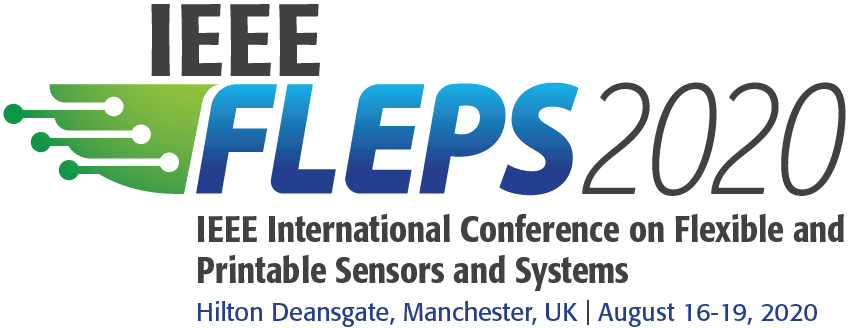|
|
Title |
Presenter |
|
10:00 -11:30 |
"Component Integration and Product Design for Printable Electronics" |
Dr. Simon Johnson, Chief Technologist within Printed Electronics, Centre for Process Innovation (UK) |
|
11:30-11:45 |
Break & Networking |
|
|
11:45 -13:15 |
"Printed Electronics from Nanomaterials: A Pathway to Ubiquitous Electronic Sensing" |
Dr. Joseph Andrews, University of Wisconsin-Madison (USA) |
|
13:15 -14:00 |
Lunch |
|
|
14:00 -15:30 |
"Wearable electronics and e-textile current trends and beyond" |
Prof. Felice Torrisi, Imperial College (UK) &University of Catania (Italy) |
|
|
Title |
Presenter |
|
10:00 -11:30 |
"Materials and Technologies for Flexible and Printed IoT Sensors" |
Prof. Sharmistha Bhadra, McGill University (Canada) |
|
11:30-11:45 |
Break & Networking |
|
|
11:45 -13:15 |
"Organic Narrowband Photodetectors: Materials, Devices and Applications" |
Prof. Vincenzo Pecunia, Institute of Functional Nano & Soft Materials, Soochow University (China) |
|
13:15 -14:00 |
Lunch |
|
|
14:00 -15:30 |
"3D printing: Materials, Technologies and Applications" |
Prof. Vassili Karanassios, Waterloo University, (Canada) |
"Component Integration and Product Design for Printable Electronics"
Abstract: Electronic circuits underpin much of modern life and have been built in the same way for many decades. While the technical developments of electronic components has been phenomenal over the past 60 year, circuits are still assembled on rigid circuit boards which, to be honest, just get in the way! However, new approaches to circuit assembly now make use of flexible substrates in place of PCBs and technologies for this are developing rapidly. In this tutorial, participants will gain an overview of the technologies which are used in the field of printable electronics and also an understanding of how printable electronics can be applied to a wide range of products including Internet of Things (IoT) applications. Topics to be covered will include: Printed sensors; Large area conductors and circuits; Photovoltaic devices; Displays and light sources; Batteries and energy storage; Integrated circuits; Flexible and ultra-thin form factors; IoT technologies for sensing and control. Participants will also learn about the challenges and solutions for combining conventional components and flexible substrates including adhesives for electronics assembly and roll to roll pick and place equipment for large area and flexible circuit assembly.
"Printed Electronics from Nanomaterials: A Pathway to Ubiquitous Electronic Sensing"
Abstract: As the connected future promised by the Internet-Of-Things expands, there is a need for ubiquitous electronic devices and sensors. New devices and sensors will need to possess a number of attributes including cost efficiency, flexibility, and the capability of operating in many environments. Printed electronics offers a pathway to enable novel form factor devices at low manufacturing costs. Additionally, recent developments in nanomaterial-based inks have facilitated the demonstration of innovative sensors able to operate in extreme environments. In this tutorial, I will present an overview of printed electronics from nanomaterials including a discussion of the printable materials and methods. I will then review sensor embodiments that have been enabled through printed nanomaterial thin films. This will include a discussion of two specific sensing systems: (1) a fully printed biological sensor capable of interrogating whole blood for a specific protein, and (2) a large-area tire tread-depth sensing array. I will conclude with a discussion on the outlook and challenges for the printed electronics field.
"Wearable Electronics and E-textile Current Trends and Beyond"
Abstract: Application of wearable electronic textiles components in displays, high frequency electronics energy harvesting and storage, photonics and lighting have fuelled the imaginary of new technology platforms for health-care, aerospace, automotive, and textile industries [1]. In this regard, electronic building blocks of the different parts of a device need to be wearable and textile-based: Semiconducting parts are needed for the active layer, insulating parts for dielectrics, and conducting parts for electrodes. For example, wearable conductive fabrics must be chemically stable (long lifetime, without the need for aggressive post treatments) [2] and highly conductive (>104 S/m) [3], while semiconducting fabric requires high charge carriers mobility (ideally larger than 1 cm2 V-1 s-1) and on/off switching ratio (>106 for digital applications) [1] Solution processable nanomaterials are particularly promising in this regard because suitable dispersion engineering can yield liquid-phase inks compatible with printing technologies and textile manufacturing while maintaining their original unique and desirable electronic, optical and mechanical properties [2]. In particular organic polymers, two-dimensional materials isolated in solution offer a source of novel materials for the creation of a platform of wearable and e-textile devices, with not only conducting, semi-conducting properties but also mechanical strength and chemical stability. Here we review the state of the art of wearable and textile electronics, and present a perspective for the future evolution and industrial uptake of this field in the areas of healthcare, automotive, sensing, protective equipment and energy.
[1] F. Torrisi et al. Nano Today 2019.
[2] J. Heo et al. Small, 14 (3), 1703034, 2018.
[3] D. Pani et al. Adv, Mater. Technol.,2, 10, 1800008, 2018
"Materials and Technologies for Flexible and Printed IoT Sensors"
Abstract: Research in flexible and printed sensors technology has led to growing commercial interests due to cost-effective manufacturing. Sensors have been one of the prominent areas of experimentation for printed and flexible electronics technology because low cost sensors are sought for IoT applications. Although flexible and printed sensors are economically attractive, their operational performance is generally poor. The tutorial session is intended to identify the root causes of some of the limitations associated with development of these sensors and propose methods to circumvent them. It will cover comparison of conventional technologies, materials used for printed and flexible sensor, their limiting factors and present emerging materials and technologies that can overcome those limitations. It will also cover how new circuit topologies can improve performance of printed and flexible sensors. The tutorial will present some examples of high performance printed and flexible sensors from the literature (with some from the author's laboratory).
"Organic Narrowband Photodetectors: Materials, Devices and Applications"
Abstract: Sensors that can detect the different “colours” of light in the visible, near-infrared (NIR), or ultraviolet (UV) range—i.e., narrowband photodetectors—are key to a broad range of applications, including emerging and rapidly evolving areas such as the Internet of Things, computer vision, and biomedicine. In recent years, narrowband photodetectors based on organic semiconductors have attracted ever-growing attention, as they provide a unique platform that overcomes many inherent limitations of conventional narrowband photodetector technologies. Importantly, due to their broad synthetic tunability, organic semiconductors offer practically limitless options in the spectral domain. Furthermore, their varied optoelectronic properties have enabled intriguing narrowband/ultranarrowband strategies, many of which have resulted in cutting-edge performance under several metrics.
This tutorial will provide a panoramic view of the exciting field of organic narrowband photodetection. The tutorial will firstly highlight the interplay among the unique properties of organic semiconductors, the specific narrowband strategies that they enable, and the performance metrics of the resulting photodetectors. These aspects will be covered in respect to all spectral regions—the UV, visible, and NIR ranges—in which organic narrowband photodetectors can deliver narrowband selectivity. Additionally, the significance of organic narrowband photodetectors will be contextualised against benchmark technologies. Finally, a discussion of device integration towards real-world applications will provide a concrete illustration of the remarkable technological potential of organic narrowband photodetectors.
"3-D Printing: Technology, Materials and Selected Applications"
Abstract: During the last several years, 3D printing has been receiving significant attention in the scientific literature and the popular press and it has generated exciting business interests, opportunities and prospects. Some consider 3D printing a transformative technology capable of impacting many areas of experimental Science, of Engineering, and of Medicine (including dentistry), to name but a few areas that will be impacted. In addition, 3D printing has often been described as a technology that has the potential to alter rapid prototyping approaches and to influence (if not disrupt) traditional methods of manufacturing. In fact, the capability of using 3D printing to make personalized (i.e., one-of-a-kind) items on-demand may offer the necessary stepping stone for a more complete implementation of the (over the horizon) Industry 5.0.
Aim of this tutorial is to provide an introduction to 3D-printing.
The content of this tutorial is (roughly) divided into five unequal parts:
- 3D printing technologies
- 3D-printing materials
- Comparison of technologies, capabilities and materials used for 3D printing
- Selected applications of 3D printing, with examples drawn from the Engineering and the Scientific literature (with some) from the author's laboratory.
- Future directions of 3D printing technology will be outlined, its potential impact on Industry 5.0 and in Society 5.0 will be briefly discussed, and general comments on its potential societal and economic impacts will be made.


.jpg)






